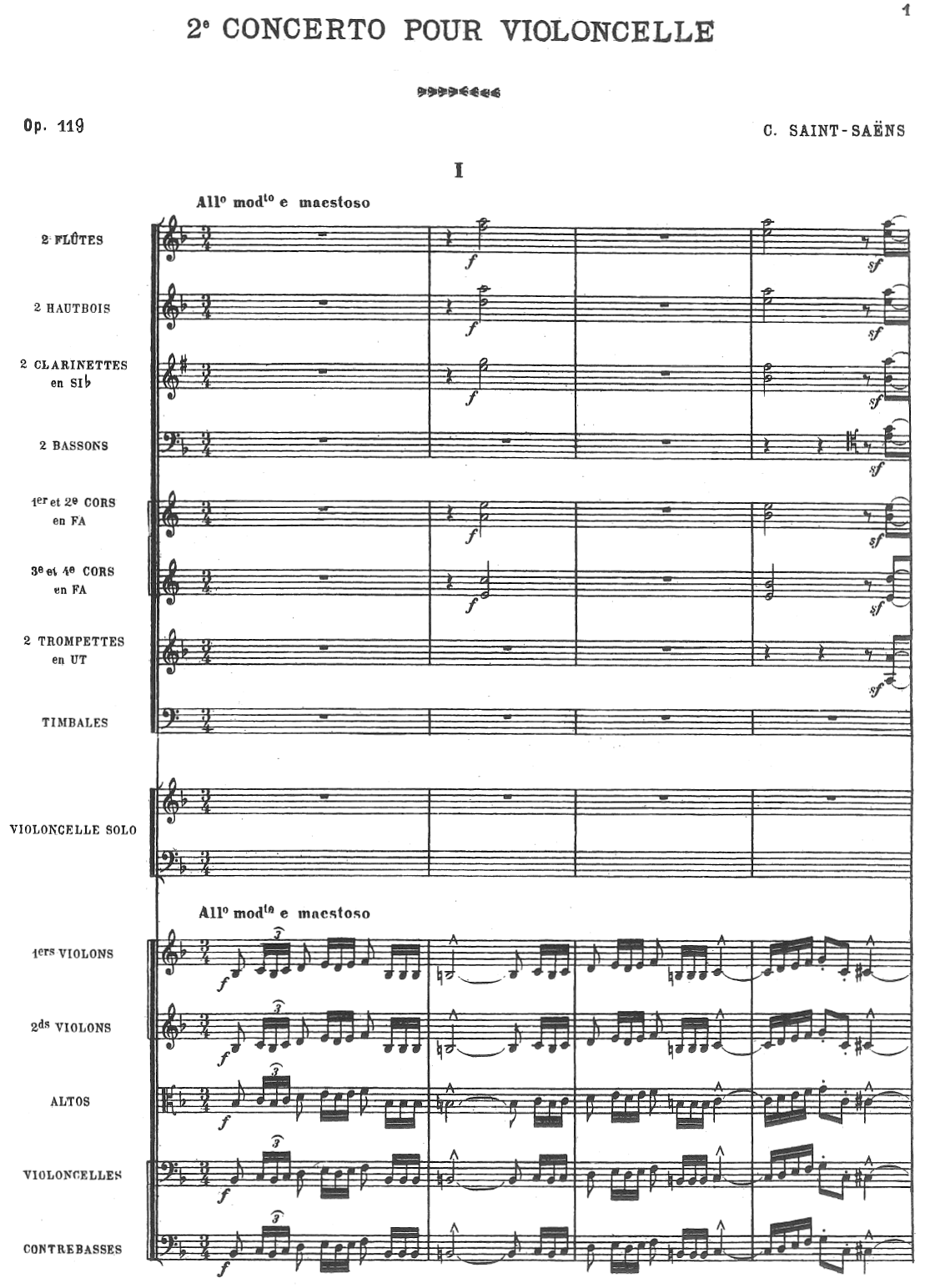

Charles Camille Saint-Saëns
(geb. Paris, 9. Oktober 1835 — gest. Algier, 16. Dezember 1921)
Zweites Cellokonzert d-moll op. 119
(1902)
I Allegro moderato e maestoso (p. 1)
Ia Andante sostenuto (p. 17) – Più mosso (p. 20) – Tempo I (p. 23)
II Allegro non troppo (p. 30) – Cadenza ad libitum (p. 49)
IIa Mouvement du premier morceau (p. 50) – Molto allegro (p. 55)
Vorwort
«Le niveau de difficulté de l’œuvre est beaucoup très élevé pour qu’il connaisse le même succès que mon premier Concerto pour violoncelle.» („Der Schwierigkeitsgrad des Werkes ist viel zu hoch, als dass es den gleichen Erfolg haben könnte wie mein erstes Cellokonzert.“) Als er dreißig Jahre nach seinem Ersten Cellokonzert a-moll op. 33 von 1872, das schnell und bis heute zu den beliebtesten und wirkungsvollsten Beiträgen zur Gattung zählen sollte, sein Zweites Cellokonzert zur Veröffentlichung freigegeben hatte, war Camille Saint-Saëns klar, dass es sich nicht gleichermaßen durchsetzen würde, zumindest aber nicht so widerstandslos. Dass dieses Zweite Konzert jedoch nach wie vor kaum gespielt wird, ist weniger verständlich, gibt es doch in unserer Zeit mehr Spieler denn je, die die extremen technischen Herausforderungen suchen und auch zu meistern imstande sind. Ein Grund hierfür mag auch sein, dass viel zu lange schon keine käufliche Partitur des Werkes mehr erhältlich war. Es ist natürlich schon bemerkenswert, dass ein Komponist der Generation Brahms so virtuos für das Cello schreibt, dass er teilweise auf zwei Systemen notieren muss, und so möge dieser erstmalige und unveränderte Nachdruck des Durand-Erstdrucks nach 110 Jahren dazu beitragen, dass unser Konzertleben gelegentlich um die Farbe eines weniger bekannten Konzerts reicher wird.
Bemerkenswert ist auch die formale Anlage des Werkes in zwei Sätzen, die sich wiederum unterteilen in klar voneinander getrennte Abschnitte. Der erste Satz besteht aus einem kraftvoll bewegten Kopfsatz und einem lyrischen ornamentischen langsamen Satz. Der zweite Satz führt nach einem Perpetuum mobile-Allegro über eine frei deklamierende Kadenz des Solisten zur Wiederaufnahme des Anfangs des Kopfsatzes, um Molto allegro mit leidenschaftlicher Verve zu schließen. Insofern vereinigt dieses Konzert Elemente sehr verschiedener Formen – sowohl der zyklisch-einsätzigen als auch der traditionell konzertant kontrastierenden.
Saint-Saëns vollendete sein Zweites Cellokonzert laut Manuskripteintrag im November 1902 und widmete es «à Monsieur Hollman», also dem in Maastricht geborenen holländischen Virtuosen Joseph Hollmann (1852-1927). Im Druck erschienen zunächst im Dezember 1902 Solostimme und Klavierauszug, dann im Januar 1903 Partitur und Stimmen bei Durand & Cie, Editeurs, Paris.
Die Urauführung spielte Joseph Hollmann am 4. Februar 1905 in Berlin. Zwei Jahre später, am 5. und 12. Februar 1905, erklang das Werk erstmals in Paris, vorgetragen wiederum von Joseph Hollmann, der vom Orchestre de la Société des Concerts du Conservatoire de Paris unter Georges-Eugène Marty (1860-1908) begleitet wurde.
Christoph Schlüren, August 2013
Aufführungsmaterial ist vom Verlag Durand, Paris, zu beziehen (www.durand-salabert-eschig.com).
Charles Camille Saint-Saëns
(b. Paris, 9 October 1835 — d. Algiers, 16 December 1921)
Second Cello Concerto in D minor, op. 119
(1902)
I Allegro moderato e maestoso (p. 1)
II Andante sostenuto (p. 17) – Più mosso (p. 20) – Tempo I (p. 23)
III Allegro non troppo (p. 30) – Cadenza ad libitum (p. 49)
IV Mouvement du premier morceau (p. 50) – Molto allegro (p. 55)
Preface
“Le niveau de difficulté de l’œuvre est beaucoup très élevé pour qu’il connaisse le même succès que mon premier Concerto pour violoncelle” (“The work’s level of difficulty is far too great for it to have the same amount of success as my first cello concerto”). Thirty years after writing his First Cello Concerto in A minor, op. 33 (1872), which quickly became and has ever remained one of the most popular and effective works in its genre, Camille Saint-Saëns released his Second Cello Concerto for publication, fully aware that it would not take hold to the same degree, or at least not as effortlessly. That it has hardly been played at all is less comprehensible, there being more cellists today than ever before who seek extreme technical challenges and are capable of mastering them. One reason may be that for far too long there was no score available for purchase. It is, of course, remarkable for a composer of Brahms’s generation to write cello music so virtuosic that it sometimes has to be notated on two staves. Our edition, a faithful reproduction of the original Durand print, is the first to appear in 110 years, and will, it is hoped, add the hue of a less familiar item to our concert repertoire.
No less remarkable is the concerto’s layout in two movements subdivided in turn into two distinct sections. The first movement consists of a forceful opening section and a lyrical and ornamental slow section. The second opens with a perpetuum mobile Allegro leading, after a freely declamatory solo cadenza, to a reprise of the start of the opening section and ending with passionate verve in a Molto allegro. Viewed in this light, the concerto conflates elements from two highly disparate forms: the cyclic single-movement form and the traditional form of contrasting concertante sections.
According to an inscription in the manuscript, Saint-Saëns completed his Second Cello Concerto in November 1902 and dedicated it “à Monsieur Hollman,” this being the Maastricht-born Dutch virtuoso Joseph Hollmann (1852-1927). It first appeared in print from the Parisian publishers Durand & Cie. in an edition with solo part and piano reduction (December 1902), followed by the full score and parts from the same publishers (January 1903). The première was given by Joseph Hollmann in Berlin an 4 February 1905. Two years later, on 5 and 12 February 1905, it was given its first hearing in Paris, again by Hollmann, with the Orchestre de la Société des Concerts du Conservatoire de Paris conducted by Georges-Eugène Marty (1860-1908).
Translation: Bradford Robinson, 2013
For performance materials please contact the publisher Durand, Paris (www.durand-salabert-eschig.com).